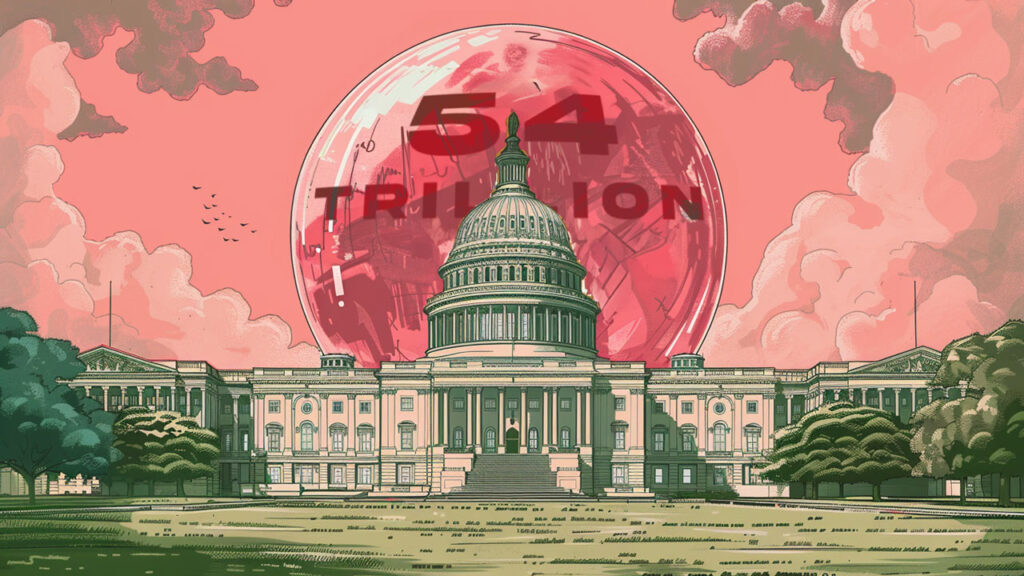$1 Trillion Per 100 Days: Is This the Year the Debt Bubble Explodes?
With a stunning trillion dollars added to the national debt in only three months, projected to reach an incomprehensible $54 trillion within 10 years, and America’s interest payments on track to exceed defense spending next year, the question must be asked: How much longer can the debt bubble go?
It’s a curious situation when Jerome Powell, a man who oversaw the largest money-printing campaign in American history, is saying that the debt is unsustainable. While maintaining that the Fed “tries hard not to comment on fiscal policy,” Powell’s suggestion for handling the debt shifts blame and burden from money printing to fiscal irresponsibility on the part of policymakers.
While they have their part to play, and it’s a big one, it’s interesting to see that Federal Reserve monetary policy hasn’t been mentioned in any of Powell’s ‘urgent’ warnings about ballooning debt:
“In the long run, the U.S. is on an unsustainable fiscal path. The U.S. federal government’s on an unsustainable fiscal path. And that just means that the debt is growing faster than the economy. So, it is unsustainable. I don’t think that’s at all controversial. And I think we know that we have to get back on a sustainable fiscal path.”
It’s a wonder how, even if the government suddenly adopted responsible spending and budgeting, we would be back on a path of true sustainability after Powell oversaw the printing of over 3 trillion dollars in 2020 alone. The Fed is an interesting source of criticism for unsustainable debt, to say the least:
M1 Supply Growth (Billions), 2000-2024, From St. Louis Fed Data
Source: Board of Governors of the Federal Reserve System (US), M1 [M1SL], retrieved from FRED, Federal Reserve Bank of St. Louis; March 6, 2024.
But as usual, the Fed only has one real tool in its toolbox: tinkering with interest rates directly to stimulate or disincentivize borrowing, or indirectly by firing up the money printer. Rate cuts expected later this year will reduce the burden of interest payments on debt growth, but simultaneously will flood the economy with newly-created money. People, already over-indebted and using credit cards for basic needs, will take advantage of a lower cost of borrowing and sign up for more loans for expenses and goods that they can’t really afford.
More loans and more deposits will increase M1 in an already-frothy inflationary environment, adding pressure to a pot that’s already in danger of boiling over from money printing during Covid. Post-COVID rate hikes have not even come close to reversing this course, with interest still far lower than it would be in an actual free market, where a few dozen bureaucrats would no longer be pulling the levers. Excessive borrowing makes US Treasurys less attractive as doubts begin to mount that the US will be able to pay its obligations back, decreasing demand for our debt and fueling further challenges for funding the government.
All of this led Fitch and Moody’s to downgrade the US’s credit rating last year, from “AAA” to “AA+” in the case of Fitch, and for Moody’s, from “stable” to “negative.” Fed interest rate hikes without an accompanying plan to reduce spending or increase revenue leave no hope at all for meaningfully reducing fiscal deficits.
From this new sense of urgency, lawmakers in Idaho and Wyoming have called for a convention of states to address the problem, with Idaho’s resolutions calling for a possible constitutional amendment limiting the spending abilities and overall power of the federal government. Idaho’s Senate Concurrent Resolution 112, or SCR 112, calls for, in its words:
“(1) imposing fiscal restraints on the federal government; (2) limiting the power and jurisdiction of the federal government; and (3) limiting the terms in office for its officials and for members of Congress. Currently, identical applications have been sent to Congress by other state legislatures.”
The question remains if anything, at this point, would be enough to get the US back on a genuinely sustainable economic track other than an outright collapse of the US dollar leading to a total monetary reset. As long as the Fed exists, the likelihood of truly reigning in out-of-control debt is nothing but a pipe dream.
With recent new all-time highs for gold and bitcoin in response to the debasement of the debt and central banks locked in a buying spree that is likely to last years, the message is clear that the banking system agrees with Peter Schiff that inflation is far from over.






 In 2009, 140 banks failed, and a recent report from financial consulting firm Klaros Group says that hundreds of banks are at risk of going under this year. It’s being billed mostly as a danger for individuals and communities than for the broader economy, but for stressed lenders across America, a string of small bank failures could quite […]
In 2009, 140 banks failed, and a recent report from financial consulting firm Klaros Group says that hundreds of banks are at risk of going under this year. It’s being billed mostly as a danger for individuals and communities than for the broader economy, but for stressed lenders across America, a string of small bank failures could quite […] Cocoa prices have dumped since rocketing to a dramatic peak last month as an El Nino cycle winds down and traders rush out of the illiquid market. For now, depreciating fiat currencies are still keeping the cocoa price still far above its 2023 levels. Coffee has had a similar rise and subsequent correction — but now, inflation and other factors are conspiring to […]
Cocoa prices have dumped since rocketing to a dramatic peak last month as an El Nino cycle winds down and traders rush out of the illiquid market. For now, depreciating fiat currencies are still keeping the cocoa price still far above its 2023 levels. Coffee has had a similar rise and subsequent correction — but now, inflation and other factors are conspiring to […] California’s government bet that they knew better than the free market. And now millions are paying the price. The story begins in 1919, when the city of Berkley, California instituted legislation setting aside districts that would only allow the construction of single-family housing. The idea spread, and soon much of California’s urban areas had adopted the zoning policy. Today, approximately 40% of the total land in Los Angeles is […]
California’s government bet that they knew better than the free market. And now millions are paying the price. The story begins in 1919, when the city of Berkley, California instituted legislation setting aside districts that would only allow the construction of single-family housing. The idea spread, and soon much of California’s urban areas had adopted the zoning policy. Today, approximately 40% of the total land in Los Angeles is […] The yen was once known as a safe-haven currency for investors to protect themselves when broader markets are shaky or other currencies are dropping, but those days are numbered. A stable government and consistent (and low) interest rates have been some of the driving factors, but it’s the unwinding of that ultra-low interest rate policy that will be the yen’s “safe […]
The yen was once known as a safe-haven currency for investors to protect themselves when broader markets are shaky or other currencies are dropping, but those days are numbered. A stable government and consistent (and low) interest rates have been some of the driving factors, but it’s the unwinding of that ultra-low interest rate policy that will be the yen’s “safe […] Whenever an election year rolls around, domestic manufacturing becomes a more central theme of discussion. Candidates from both sides, who seem to disagree on almost everything else, never waver in their commitment to auto manufacturers in Detroit and the steel industry. Republicans and Democrats never forget to remind the American public that they will try […]
Whenever an election year rolls around, domestic manufacturing becomes a more central theme of discussion. Candidates from both sides, who seem to disagree on almost everything else, never waver in their commitment to auto manufacturers in Detroit and the steel industry. Republicans and Democrats never forget to remind the American public that they will try […]